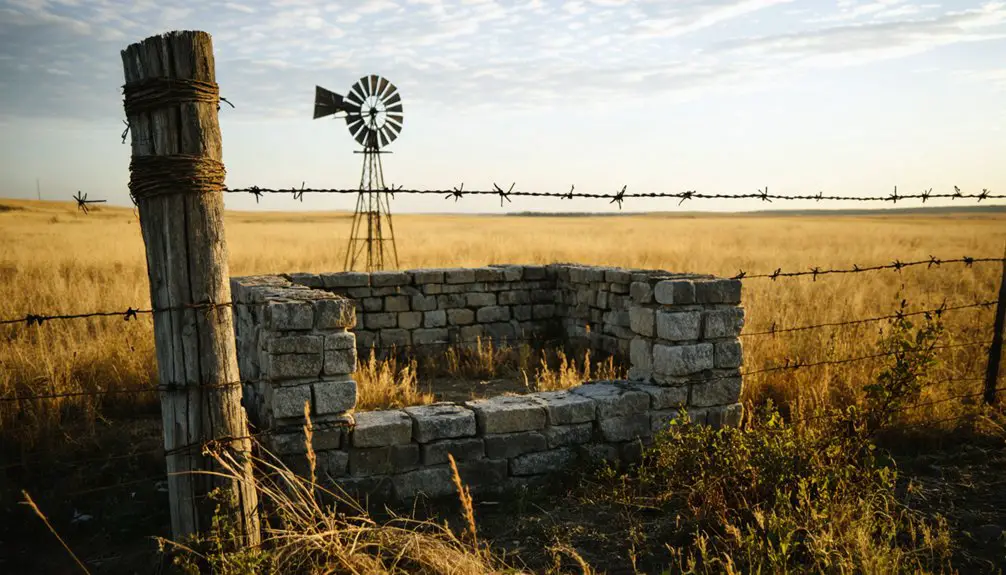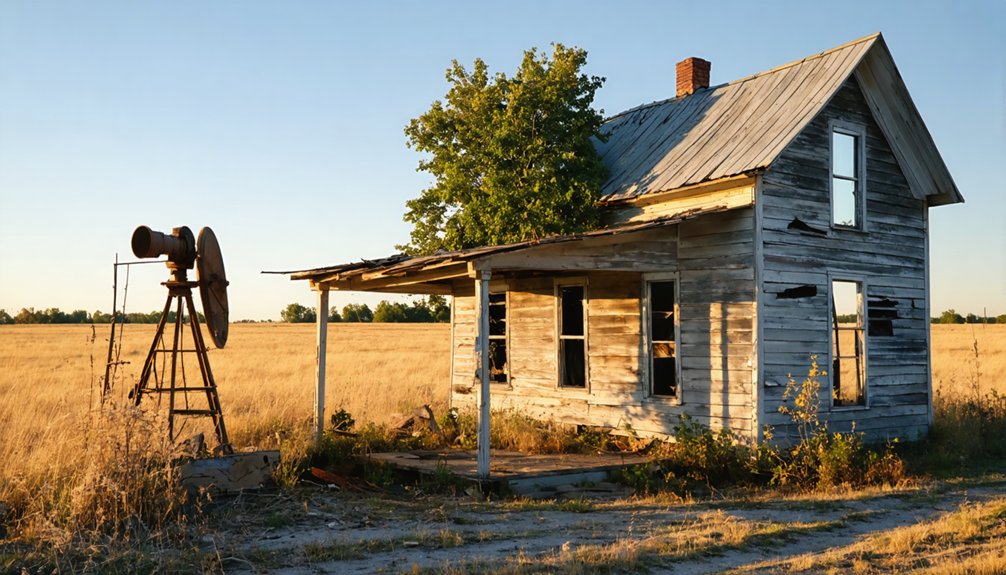You’ll find Pearlette, Kansas was established in 1879 by settlers from Muskingum County, Ohio, naming it after early settler Pearl Atkinson. The town initially thrived through mutual aid and cooperation, with “The Pearlette Call” newspaper and dance houses serving as social hubs. When the Rock Island Railroad bypassed Pearlette for Fowler in 1887, the town’s fate was sealed. The post office’s closure that February marked the beginning of the end, but Pearlette’s pioneering spirit lives on through preserved stories.
Key Takeaways
- Pearlette was established in 1879 by Ohio settlers and named after Pearl Atkinson, but became a ghost town following economic decline.
- The loss of mail service and failed railway connections in 1887 triggered the town’s decline and eventual abandonment.
- Severe droughts in the late 1880s and 1890s, combined with isolation, forced residents to leave despite wheat yields of 20-25 bushels.
- Dance houses and “Red Hot Street” served as vital social hubs for the community before its eventual downfall.
- The Old Meade County Museum now preserves Pearlette’s history through artifacts, documents, and settler experience records.
A Frontier Colony Born From Mutual Aid
When a group of determined settlers from Muskingum County, Ohio, arrived in southwestern Kansas in 1879, they established Pearlette Colony with a distinct vision of community support.
You’ll find their settler cooperation evident in how they traveled together from Dodge City along the Adobe Walls trail, claiming land as a unified group rather than isolated homesteaders.
Named after Pearl Atkinson, an early settler who died shortly after arrival, Pearlette’s founding reflected the community’s deep bonds.
Pearlette Colony carried the memory of a lost pioneer, her name becoming a symbol of the settlers’ shared dedication.
The colony’s focus on mutual aid proved crucial as settlers faced raw prairie conditions. Their community resilience shone through shared construction projects, including Ed Thompson’s first frame house, and the establishment of essential infrastructure like the post office under Bennett’s leadership. The Pearlette Call newspaper, launched in April 1879, became a vital source of local news and community connection.
Within months, twenty families had joined the colony, strengthening their cooperative network. The settlers faced significant challenges including drought and strong winds that forced many men to seek work elsewhere.
Life and Loss in Early Settlement Days
Though early settlers of Pearlette displayed remarkable resilience through mutual aid, daily life remained brutally challenging on the open prairie. You’d find yourself facing vast, empty landscapes with minimal shelter and scarce resources, where even basic needs required extraordinary effort.
Settler challenges included walking half a mile through the prairie at night just to help a neighbor during childbirth. With no formal healthcare, you’d rely entirely on community resilience – your neighbors became your lifeline.
The weekly post office delivery served as your only connection to the outside world. While about 20 new families joined the settlement by May, survival demanded constant adaptation. Like many ghost towns in Kansas, their settlement pattern mirrored the thousands of other communities that faded away. Like many Kansas settlements that faced harsh conditions, Pearlette eventually succumbed to bad weather conditions that drove residents away.
You’d witness the slow construction of infrastructure, with the first frame house marking a pivotal moment in establishing permanence on this unforgiving frontier.
The Dance Houses and Social Fabric
Despite moral concerns from some locals, Pearlette’s dance houses emerged as essential social hubs that operated daily, including Sundays, alongside the town’s saloons and gambling establishments.
You’d find these dance hall dynamics particularly vibrant along what locals called “Red Hot Street,” where the venues brought together miners, farmers, and transient workers under one roof.
The dance houses weren’t just about entertainment – they helped maintain the town’s social fabric during uncertain times. Similar to how Trading Post residents gathered at community venues, these social spaces fostered connections between diverse groups. Even as Pearlette faced economic challenges, these community gatherings continued to provide a sense of continuity and connection.
While churches and civic groups might’ve frowned upon the associated gambling and drinking, the dance halls remained deeply embedded in daily life, serving as landmarks of local culture until the town’s eventual decline. The town’s often chaotic atmosphere led to violent feuds between residents, making these social venues even more crucial as neutral meeting grounds.
Railroad’s Impact on Town Destiny
As railroad companies plotted their routes through Kansas in the late 1880s, Pearlette’s destiny hung precariously in the balance.
When the Rock Island Railroad designated Fowler as a division town in 1887, it dealt Pearlette a devastating blow, leading to the loss of its mail service.
You’ll find that subsequent attempts to attract railway routes, including the Kansas, Texas & Southwestern and the Dodge City, Montezuma & Trinidad lines, all failed to materialize.
The town’s economic viability plummeted without rail connectivity, especially during the severe droughts of the late 1880s and 1890s.
Like Santa Fe, Kansas, which raised over $10,000 for railroads but was ultimately bypassed, Pearlette’s efforts to secure rail service proved futile.
While rail towns like Fowler thrived with increased settlement and business diversity, Pearlette experienced a mass exodus.
The harsh reality was clear – in an era when railroads determined a town’s fate, being bypassed meant almost certain death.
Similar to Ottawa’s experience, which saw its population reach 6,250 by 1872 thanks to railroad development, towns without rail service struggled to maintain their populations.
Native American Relations and Regional Conflict
When Native Americans first encountered white settlers in what would become Pearlette, the region was home to several established tribes including the Kansa, Osage, Pawnee, and Comanche. As tribal treaties forced Native Americans to cede their lands, tensions mounted between settlers and indigenous peoples. The French initially made contact with tribes in the 1700s when Sieur de Bourgmont documented Kanza villages near the Missouri River.
- Settlers often moved onto Native lands before treaty ratifications were complete.
- Local settlers formed Mutual Protection Societies to defend their claims.
- Land disputes frequently arose from unclear property boundaries and claim jumping.
- Annual fees of $1 were required from settlers to appease Osage claims.
- Vigilante groups sometimes used armed threats to protect their interests.
Though violence occasionally erupted, the abundance of open land helped channel many conflicts through legal channels instead of physical confrontation. The region’s settlement pattern reflected the broader story of westward expansion, with Pearlette emerging from these complex Native American relations.
The post-war treaty with the Osage in 1865 brought a significant influx of new settlers to the area, further straining relationships between natives and newcomers.
The Final Days of a Prairie Community
The final days of Pearlette unfolded through a series of economic and social setbacks in the mid-1880s.
You’d have witnessed the town’s community resilience tested as land ownership disputes erupted, culminating in a tense July 1885 incident when 14 armed men confronted a local real estate agent over contested claims.
While 1885 brought a glimmer of hope with wheat yields reaching 20-25 bushels per acre, Pearlette’s fate was sealed when the railroad designated nearby Fowler as a division town.
By February 1887, you’d have seen the post office close, marking the beginning of the end. The town’s isolation became stark – at one point, you’d find just one permanent neighbor within three miles.
As services disappeared and residents sought opportunities elsewhere, Pearlette faded into prairie history.
Preserving Pearlette’s Place in Kansas History

Modern preservation efforts have kept Pearlette’s memory alive long after its physical decline. Through historical documentation and community engagement, you’ll find dedicated groups working to guarantee this ghost town‘s story endures for future generations.
- The Old Meade County Museum curates extensive records of settler experiences and the Jones and Plummer Trail.
- Local historical societies conduct educational programs and guided tours highlighting pioneer settlement patterns.
- Volunteer groups maintain physical structures and markers at the site.
- Archaeological surveys document artifacts and structural remnants.
- Digital archives make photographs, maps, and legal documents accessible to researchers.
You can explore Pearlette’s legacy through preserved newspaper accounts, archived photographs, and oral histories from settler descendants.
Regular community events feature storytelling and reenactments, while school programs integrate the town’s history into local curricula.
Frequently Asked Questions
What Was the Average Population of Pearlette During Its Peak Years?
You’ll find population trends indicate around 80-100 residents during peak years, based on the arrival of 20 families and typical household sizes of the late 19th century frontier settlements.
Are There Any Remaining Structures or Ruins Visible in Pearlette Today?
You’ll find limited historical remnants in the area today. Though specific documentation is scarce, it’s likely any abandoned buildings have deteriorated considerably, following patterns typical of Kansas ghost towns.
Did Pearlette Have a School System During Its Active Years?
Like a ghost in the historical record, you won’t find clear evidence of a school system. Despite frontier towns typically having education facilities, there’s no documented school history in Pearlette.
What Crops Were Primarily Grown by the Farmers of Pearlette?
You’d find corn production dominated the early farming landscape, with wheat cultivation later becoming prominent as Turkey Red wheat varieties proved more suitable for the challenging Kansas environment.
Were There Any Notable Weather Disasters That Contributed to Pearlette’s Decline?
You won’t find evidence of major weather impact or disaster effects contributing to the town’s decline. The primary causes were railroad changes and postal service discontinuation in February 1887.
References
- https://www.visitoldmeadecounty.com/pearlette
- https://en.wikipedia.org/wiki/Mortimer
- https://historyandersoncoks.org/towns
- https://www.youtube.com/watch?v=OyBXD18P_j4
- https://en.wikipedia.org/wiki/List_of_ghost_towns_in_Kansas
- http://www.kancoll.org/khq/1941/41_4_gaeddert.htm
- https://legendsofkansas.com/kansas-time-line/
- https://archive.org/download/conquestofsouthw00blan/conquestofsouthw00blan.pdf
- https://legendsofkansas.com/wild-west-kansas/
- https://www.hhhistory.com/2019/05/ghost-towns-of-kansas.html



